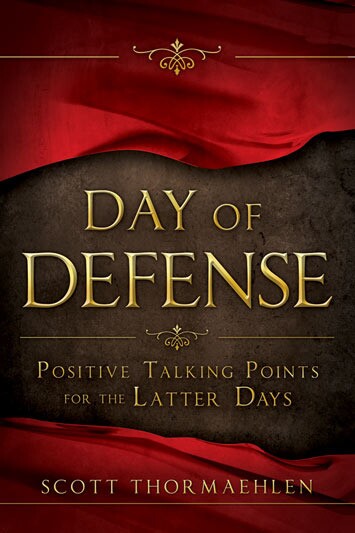
Once again, general conference has come and gone, and members of the Church are left with the words of prophets and apostles of the Lord who expressed key fundamentals for sharing the gospel. These fundamentals included: gaining a larger view of the plan of salvation, possessing a sound understanding of the scriptures, and sharing without a contentious spirit. In addition, authorities counseled against trying to prove the gospel’s truth; however, they urged members to work diligently to spread the message of the Restoration so it can be heard above those who misrepresent LDS beliefs.
It has been both the duty and the burden of prophets and saints in past dispensations to declare the power and truth of “one lord, one faith, and one baptism” (Ephesians 4:5). No era has been without challenges, and the latter days are no exception. Below are five ways Latter-day Saints can prepare to handle tough gospel questions.
1) Use common doctrine to bridge gaps.
Know what some common misconceptions about the Church are. When you encounter someone with this misconception, use common beliefs or scriptures to help them understand the doctrine we do believe."
One effective method that Christ used in His teachings was to allow His opposers’ questions and assumptions to be heard, which He would then respond to with His own theology and the same scriptures His critics revered. This built common ground between the Savior and those who would follow Him.
By following the Savior’s example, Latter-day Saints can capture what religious investigators have to say and build upon their understanding.
Example: Many groups mistakenly believe that Latter-day Saints think they are saved by works and not grace. This is simply untrue, as we read in Matthew 5:16, John 13:15, Romans 2:10, and half a dozen other biblical references about grace that Mormons accept as doctrine. Members of the Church can bridge many misconceptions like this with biblical teachings.
Get more help handling difficult gospel questions in Day of Defense: Positive Talking Points for the Latter Days.
Have you ever been challenged with difficult questions about your LDS beliefs and didn't know what to say? Day of Defense walks you through many of the stumbling blocks and confusing topics today's saints encounter when discussing their religion. You will gain a clearer understanding of your beliefs as you read, and you will learn how to help your friends appreciate your views.
-->Learn more positive talking points
2) Understand how the restored church of Jesus Christ is patterned after ancient church organization.
Many arguments against the Church stem from the belief that it is an illegitimate Church, not rooted in general Christian traditions.
However, the cycle of apostasy and restoration, coupled with the priesthood of God and the calling of prophets, creates a common basis with friends of other Christian faiths. Just as the Savior relied on the teachings of the Old Testament to testify of the truthfulness of His message, Latter-day Saints can establish a similar context for the doctrines they share and the source of the Church’s inspiration. In other words, it’s important to understand and help others understand that the LDS Church is anything but a new religion; rather it is a restoration of an ancient pattern.
Example: Since the beginning of time, God has spoken to man. This process of choosing His servants—which kept the faith in unity and confounded false doctrine—was expressed in the teachings of Paul and throughout the New Testament as a key doctrine.
Although the ancient office of apostles ended before the close of the first century AD, the need for a divine mouthpiece to provide religious guidance in times of confusion has never been more relevant. God called men of authority then and has done so again in this day and age.
3) Recognize the differences between the LDS faith and other Western religious beliefs.
Throughout history, many Christian sects claimed to represent “orthodox Christianity,” therefore the revelations of Joseph Smith seemed foreign to them all.
Knowing where one of another faith is coming from—their history—we can hopefully build bridges as we share the purpose of the First Vision and restoration of the priesthood. By viewing the different reform movements, we also further understand the need for and significance of what Joseph Smith experienced.
Example:. All of mainstream Christianity, besides the Catholic Church, grew out of a time when the free exercise of religion and expression increased side-by-side with literacy and biblical exploration. Many arguments resulted in thousands of new Christian sects, including our own. In Day of Defense, I echo what other Christian historians acknowledge, and that is that many “Countless American Christians...rushed to discover the pattern of the primitive church” (Allen, Discovering Our Roots: The Ancestry of Churches of Christ, 92). The very foundations of many churches today sprang from the period of the Second Great Awakening, some just a century or two earlier, all hoping to return to the first-century Christian faith. The significance of God speaking to man again in the Sacred Grove compliments the experiences and pattern most are familiar with in their Bible.
4) Rely on the Savior for help by becoming “one with God.”
Many wonder how one true church can exist if there are so many people in the world and so many different beliefs. Today, the religious world remains divided even though prophets now and in the past have declared the gospel as the perfect prescription to all human ills.
This division can be a source of contention between those of differing religious beliefs. However, God expressed His wish—that man be unified with Him—through Christ and the apostles, as they warned against division from one another.
Uniting ourselves with the Savior will help us to handle contention with grace.
Example: In John 17:21, Christ prayed to the Father that all may be one with God and each other, as He is with the Father. This prayer illustrates God’s desire for all to be like Him and to follow the teachings of Christ. As saints individually strive to become like God, the collective goal of the Church expands. Followers of the restored gospel form a worldwide body of believers and, as predicted by Joseph Smith, continue to raise the human condition with their missionary and humanitarian efforts.
5) Utilize the gospel tools available.
While the scriptures seem to be the most obvious tool, the footnote cross-references, Bible Dictionary, and Topical Guides are also great resources to help you understand a particular gospel topic. Additionally, LDS.org, general conference talks found in the Ensign, and Church social media should also be utilized regularly.
By using these tools, you can research particular topics and be better prepared for those in-the-moment conversations with those of other faiths or those struggling within the LDS faith. You may also find it helpful to enlist the aid of local missionaries before, during, or after these tough conversations.
Example: It is often the doctrines unique to the Restoration, such as the pre-existence, plural marriage, and the three degrees of glory, that create concern for the critics of the Church. For example, searching in the Topical Guide for topics like “premortal life” or “resurrection,” give you an organized list of the biblical references to these doctrines—references that provided the basis for many of the revelations received by the Prophet Joseph Smith. By comparing scriptures side by side in this way, a mosaic of common beliefs spanning across time comes into view and shows that God truly is the same today, yesterday, and forever.
As members of The Church of Jesus Christ of Latter-day Saints are presented with tough gospel questions, the most important thing to remember is the counsel given by the general authorities: stand fast until additional knowledge is available, always “doubt your doubts,” focus on the gospel essentials, rely on the eternal perspective, and gain a testimony of scripture and modern-day revelation.
Get more help handling difficult gospel questions in Day of Defense: Positive Talking Points for the Latter Days.
Have you ever been challenged with difficult questions about your LDS beliefs and didn't know what to say? Day of Defense walks you through many of the stumbling blocks and confusing topics today's saints encounter when discussing their religion. You will gain a clearer understanding of your beliefs as you read, and you will learn how to help your friends appreciate your views.

